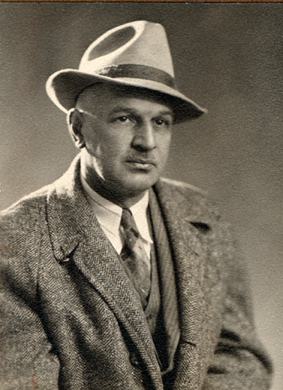
Philip Homer Elwood
Philip Homer Elwood was born in Fort Plain, New York on December 7,
1884 to Philip and Alice Elwood. He received his B.A. (1910) in Landscape
Architecture from Cornell University. He then worked as a Civil and Landscape
Engineer in the firm of Charles W. Leavett of New York City (1910-1913), as an
Agent for the Agricultural Extension Service of the Massachusetts State College
at Amherst (1913-1915), as the head of the Department of Landscape Architecture
at Ohio State University (1915-1923), and as a Landscape Architect in the firm
of Elwood and Frye (1920-1923). He also served as a field artillery captain in
the First World War, and in 1919 he acted as the Chief Landscape Engineer during
construction of the Argonne Cemetery in Romagne-sous-Montfaucon, France.
In 1923, Elwood was hired as a Professor of Landscape Architecture at Iowa State
College (University) and helped to organize the new Department of Landscape
Architecture. He was made head of the department in 1929 and served in that
capacity until 1950. Elwood was named Professor Emeritus in 1958. During his
time at Iowa State, Elwood conducted several summer travel tours for students to
Asia and Europe, and throughout North America. He also published numerous
articles and served as the editor of American Landscape Architecture. Elwood
retired from Iowa State in 1951 and started a landscape architecture firm,
Elwood and Greene, in Tucson Arizona.
Aside from his academic career, Elwood also served on several commissions and
completed many professional projects. He served on the National Resources
Planning Board (1940-1943), the Missouri Valley Regional Planning Commission
(1941-1943), and the Mississippi River Parkway Planning Commission (1932-1950).
He was a Town Planner for the U.S. Army Engineers on the Garrison Reservoir Town
site, a Site Planner for Boys Town, near Omaha, Nebraska, and he made up the
master plan for Canon City Colorado in 1948 and 1949.
Elwood was active in several social and professional organizations, including
the American Society of Landscape Architects, the American Planning and Civic
Association, the American Society of Planning Officials, Tau Sigma Delta, the
honorary landscape architecture organization, and Tau Kappa Epsilon fraternity.
Elwood was married to Dorothy Elwood, and had two children, Mary and David.
Elwood died in Tucson, Arizona on August 20, 1960.
